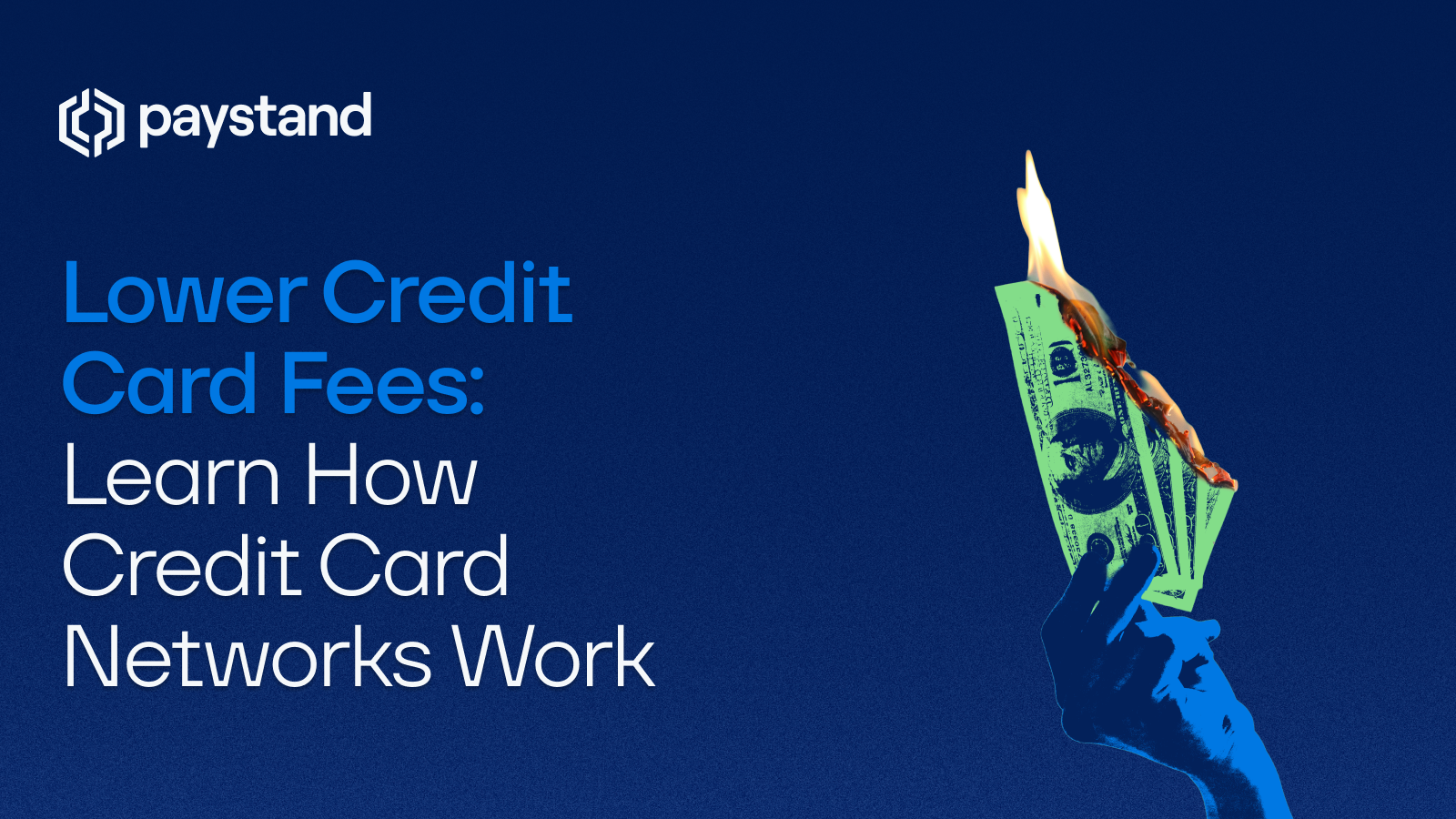Lower Credit Card Fees: Learn How Credit Card Networks Work

Table of contents
- What are Credit Card Networks?
- Types of Credit Card Networks (and Their Fees)
- How Does a Credit Card Network Work?
- What is the Difference Between a Credit Card Issuer and a Credit Card Network?
- Why do credit card networks matter for businesses?
- Applying and optimizing credit card networks to your business
Key takeaways
-
Credit card networks connect cardholders, banks, and merchants to enable fast and secure digital transactions worldwide.
-
Major networks like Visa, Mastercard, American Express, and Discover have varying fee structures that impact business costs.
-
Knowing the difference between card issuers and networks helps businesses choose smarter, lower-cost payment options.
-
Paystand empowers companies to reduce credit card fees and improve cash flow through fee-free digital payment solutions.
Most B2B finance teams agree: Checks are cumbersome and outdated, but credit cards are expensive. With fees that can reach up to 3.5% of every transaction, receiving credit card payments can quickly turn from a small leak to a hemorrhaging of cash. Business-to-business purchases feel heavier than consumer goods. Higher prices translate into higher fees.
The solution to reducing fees and saving more on every B2B payment is simple. Accounting teams must discover new strategies to leverage credit card networks. A key first step is understanding how card networks work and where those costs come from.
All credit card transaction fees and requirements, no matter the issuer, hinge on the network. The good news: There are only a few major networks. The bad? You do need to develop a nuanced plan to tackle these different networks, if you want to stop the revenue leak.
What are Credit Card Networks?
A card network (also known as a card association) is an organization that facilitates credit card payments between cardholders and merchants. As a type of digital payment, credit card payments can be processed worldwide, and funds are moved from customers to merchants in just a matter of seconds – all thanks to credit card networks. These networks build virtual payment infrastructure and charge merchants interchange fees for their work to process credit card payments.
Types of Credit Card Networks (and Their Fees)
The four major types of credit card networks are American Express, Mastercard, Visa, and Discover.
Each of these has its own fee structure and requirements, with American Express typically being higher than Mastercard and Visa. For example, the 2024-2025 total average fees for in-store and online purchases include:
|
Credit Card |
Fees |
|
Visa |
1.15% + $0.25 to 3.15% + $0.10 |
|
Mastercard |
1.15% + $0.05 to 3.15% + $0.10 |
|
American Express |
1.10% + $0.10 to 3.15% + $0.10 |
|
Discover |
1.56% + $0.10 to 2.40% + $0.10 |
How are these rates determined? There is a combination of costs, namely: Interchange fees, assessment fees, and payment processing fees. These also differ per network due to how these fees are calculated. Most merchants will see significant differences between interchange and payment processing fees.
For example, an interchange fee is charged by the credit card issuer—basically, the bank. Each card issuer calculates its fee independently, so this can differ widely.
The other variable fee is the payment processing fee. This is charged by the card processor, and may be built on a transaction or a monthly cost. Your credit card processor can dramatically affect the final cost of accepting credit card payments.
How Does a Credit Card Network Work?
Credit card networks ensure that when a customer swipes his or her credit card or enters his or her card information to buy something, funds move from the customer’s account to the company's merchant account, selling the desired product or service. In doing so, these networks facilitate transactions between banks, merchants, and cardholders securely and in real time. This occurs through the help of a payment processor: a vendor service that allows businesses to accept card payments by managing the logistics of credit and debit card transactions for them.
Typically, to be able to process credit card transactions, businesses need a merchant account (also called a merchant acquirer), but this requires a specific approval process, a business license, and an agreement that your business submits to underwriting.
Payment processors eliminate the need for businesses to go through the headache of securing their merchant accounts. Instead, they manage the credit card transaction process by serving as the bank and merchant middleman. Payment processors authorize payments by verifying a customer’s billing information, confirming that the customer’s funds are actually available in the customer’s bank account, and transferring the money to the seller’s merchant account. This entire process occurs in a matter of seconds.
Similarly to how payment processors act as the middlemen between banks and merchants, payment gateways operate as the middlemen between payment processors – and in some cases, merchant accounts – and credit or debit card companies. Payment gateways connect a business’s customers’ financial accounts to its merchant account. The payment gateway reads and transfers payment information from a customer’s bank account to a business’s account by capturing the necessary payment information and ensuring the funds for the desired transfer are available.
Essentially, through the help of payment processors and payment gateways, credit card networks authorize and approve transactions: they authorize that the cardholder is, in fact, the person who is making the transaction (in other words, they try to prevent fraudulent transactions at all costs) and they approve the transaction by making sure that there are enough funds in the customer’s credit card account to make the payment go through.
What is the Difference Between a Credit Card Issuer and a Credit Card Network?
.A credit card issuer is a financial institution that issues credit cards to customers, whether those customers are businesses or consumers. Credit card issuers, or issuing banks, create, manage, and approve applications, allowing their customers to obtain credit card accounts.
Credit card accounts can be very beneficial when it comes to borrowing money, increasing credit, and earning reward points. Credit card issuers are members of the card schemes, i.e., credit card payment networks such as Mastercard or Visa; however, it is possible for credit card issuers to operate as both the issuer and the card scheme itself. Some of the biggest credit card issuers, including Wells Fargo, Chase, Citi, Discover, U.S. Bank, Capital One, American Express, and Bank of America, are examples of closed networks, since they both issue their own cards and process the transactions within their own systems..
Some companies operate as both the card network and the card issuer. However, some companies only function as card networks, while others operate as card issuers. For example, Visa and Mastercard are only credit card networks, not credit card issuers. Wells Fargo and Capital One are only credit card issuers; they themselves are not credit card networks. American Express and Discover, on the other hand, are both credit card issuers and credit card networks. This is why it’s common to see cards solely branded as American Express cards.
However, there are instances where American Express agrees to operate as the network for a particular card but does not agree to be the issuer. Since Visa and Mastercard only function as card networks, you’ll never see a card with only Visa or Mastercard branding. As a result, Visa and Mastercard work with separate financial institutions to issue credit cards.
Why do credit card networks matter for businesses?
For consumers looking to get a new credit card, understanding the difference between credit card issuers and credit card networks can help make a more informed decision about what kind of card to get. Credit card networks have the ability to determine where certain cards are accepted, and they can also determine the benefits that the cardholder qualifies for. The card issuer, however, decides who gets approved for its cards.
Additionally, it’s important for businesses to understand how the card networks work and that they usually require a flat fee and a percentage of every transaction. In fact, these fees can be as high as 3.5% of every transaction, meaning businesses are forced to sacrifice as much as 3.5% of all revenue that comes in through credit card payments. Therefore, it’s important for businesses to have this information to make informed decisions about the kind of payments they want to accept.
If you’re looking for a zero-fee B2B payment solution that can help your company move away from credit card payments for good, make sure to schedule a time to speak to one of our payment experts here.
Applying and optimizing credit card networks to your business
You might be thinking, “Okay, so understanding credit card networks can boost or drain my revenue. Now what?” Applying best practices or knowledge to solving your payment problems isn’t as straightforward as it looks.
Let’s take a look at an example.
Headquartered in Maple Grove, Minnesota, industrial coating brand Penntek faced common challenges with payment processing. Inefficient manual check processing and high credit card fees prevented the organization from properly leveraging its revenue stream. To solve this problem, they took a strategic approach to payments.
Within 6 months, they saved $65,300 and doubled transaction volume. One factor into this success was modernizing their credit card processing system and finding ways to compensate for network costs. You can get the full details of their transformation in our in-depth case study: $65K Saved in 6 Months: How Penntek Doubled Payment Efficiency.







